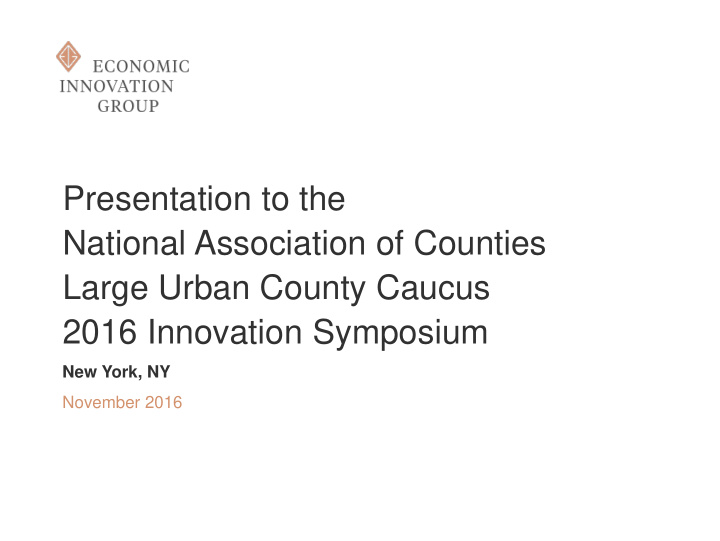



Presentation to the National Association of Counties Large Urban County Caucus 2016 Innovation Symposium New York, NY November 2016
Large counties are leading a shift in the country’s economic landscape Counties with over 500,000 people accounted for 64 percent of the country’s job creation in the 2010s recovery – compared to only 37 percent in the 1990s. Share of Net U.S. Job Creation by County Size Class 2
The geography of job growth has inverted The geographic patterns of job growth have reversed almost completely over the course of the past three recoveries, such that rural areas and mid-sized counties now trail metropolitan peers. Average job growth rates by county size class 3
Job growth has concentrated Over the past three recoveries, the geography of job growth has narrowed swiftly. As growth concentrates into more populous places, however, a consistent share of the country’s population— around 45 percent – still lives in a county matching the national of job growth. Share of U.S. counties matching or exceeding national job growth 4
County-level decline has become more pervasive during recoveries Percent of counties losing jobs 2002-2006 1992-1996 2010-2014 Percent of counties losing businesses 2010-2014 2002-2006 1992-1996 5
We now have a startup-less recovery Had the number of establishments increased from 2010 to 2014 as quickly as it did during the 1990s recovery, the economy would have had 329,000 additional new businesses by 2014. Net change in U.S. business establishments 6
The map of business creation is shrinking The 1990s recovery was powered by widespread growth of new enterprise. 7
The map of business creation is shrinking The 2000s recovery saw fewer counties carry more weight. 8
The map of business creation is shrinking The 2010s recovery of business establishments is the weakest and most concentrated on record. 9
Large counties remain the last bastion of enterprise growth … The nationwide collapse in new business formation reflects a widespread slowdown in small and mid-sized counties , as large counties remain relatively resilient. Average establishment growth rates by county size class 10
...But growth is neither universal nor broadly shared • Despite their dominance of the 2010s recovery, most large counties continue to underperform their past rates of growth. • Only 15 of the country’s 130 counties with over 500,000 people had their strongest recovery in the 2010s. • And within counties, growth has not been evenly shared. 11
Large Counties Posting Their Fastest Recovery Rate in 2010s Alameda County, CA Miami-Dade County, FL Allegheny County, PA Monroe County, NY Bronx County, NY Passaic County, NJ Denver County, CO Queens County, NY Erie County, NY San Francisco County, CA Harris County, TX San Mateo County, CA Hudson County, NY Santa Clara County, CA Kings County, NY 12
The DCI explores disparities in economic well- being by zip code EIG’s Distressed Communities Index (DCI) maps economic well-being down to the zip code level. It captures data from more than 26,000 zip codes (all those with populations over 500 people). In total, it covers 312 million Americans. 13
EIG’s research finds a nation pulling apart 84.4 million Americans live in prosperous zip codes, while 50.4 million reside in distressed ones. 39 percent of the population in distressed communities live in high or very high density urban zip codes. Half of the distressed zip code population resides in the South. More than 20-point gap in poverty, job growth, and establishment growth rates between prosperous and distressed zip codes. Only 9 of the country’s 100 largest cities feature broadly shared prosperity. 14 National recovery didn’t lift prosperity in distressed zip
Startling gaps across separate prosperous from distressed locales Prosperous communities enjoy extremely rapid growth while distressed communities remain mired in economic decline. These diverging trajectories exacerbate gaps on other indicators of well-being. Average Prosperous 6% 6% 35% 5% 146% 17.4% 8.8% Zip Code Average Distressed 23% 27% 55% 14% 68% -6.7% -8.3% Zip Code We tend to think of these inequalities as broadly regional patterns, but in reality prosperous and distressed communities often exist side by side within the same 15 county or metro area.
Large urban counties can be home to boom and blight simultaneously In San Antonio (Bexar County) , 20 miles and 20 minutes separate zip codes that are worlds apart in social and economic terms. Connecting wider county or metro-level growth to the corners that need it most remains a major challenge. 16
Patterns of distress often follow municipal boundaries Population in distressed zip codes for U.S. cities with more than 50,000 residents 17
What can large urban counties do? New business creation should be a key priority for county leaders in the years ahead. They can get started here: Place geographically and demographically inclusive entrepreneurship entrepreneurship at the center of economic development strategy Advocate on behalf of startup communities with state and congressional leaders Review local regulations and their impact on starting a business Don’t be afraid of experimentation 18
EIG brings together leading entrepreneurs, investors, economists, and policymakers from across the political spectrum to address America’s economic challenges. WEB EMAIL eig.org info@eig.org facebook.com/EconomicInnovationGroup linkedin.com/company/economic-innovation-group twitter.com/InnovateEconomy
Recommend
More recommend